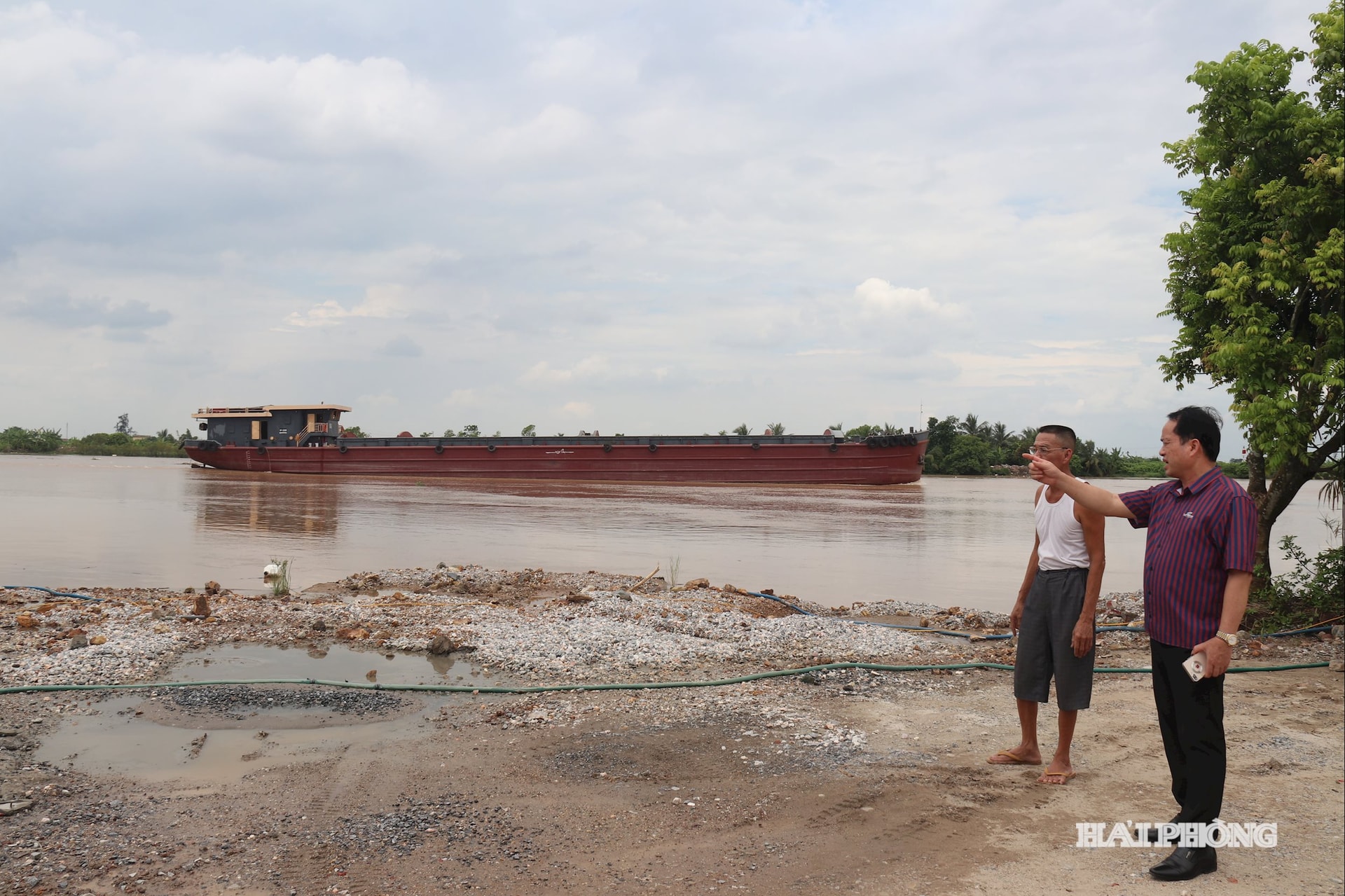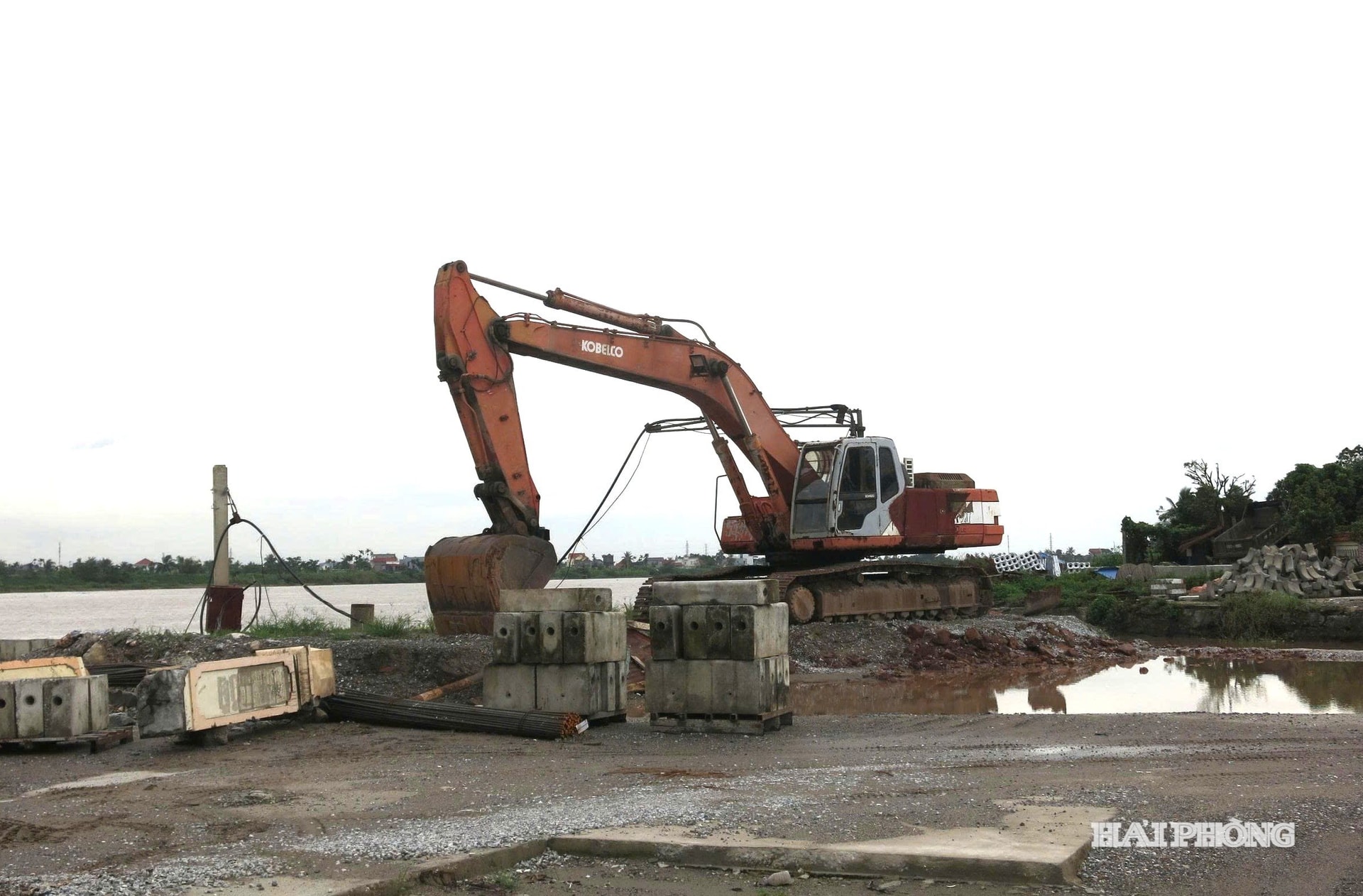
Many wharves and docks are operating without permits.
Hai Phong has a dense network of rivers and canals, with major rivers such as the Cam River, Lach Tray River, Van Uc River, and Thai Binh River serving both as waterways and involved in cargo handling and transportation. This also creates favorable conditions for the proliferation of sand, stone, and construction material storage yards along both banks of the rivers.
However, not all wharves and storage areas have operating licenses. Some have existed for many years, operating normally, but have not yet met the conditions for licensing. According to Mr. Trinh The Lu, Head of the Economic Department of An Quang commune, there are 14 wharves and storage areas along the river in the commune. Most of these wharves and storage areas have been operating spontaneously for a long time and have not yet completed the necessary procedures for operation and business. These wharves and storage areas exist due to the local people's need for materials. They are located in important positions, serving as staging areas for dike reinforcement during disaster prevention and control.
Mr. Bui Van Khang, who operates a 2,560 m² wharf in Ha Nam commune, said that his family was granted a business license for a wharf in 2014, and it will be renewed for another 25 years in 2025. Currently, his family's wharf deals in various minerals but has not yet been granted a license to trade in sand and gravel.
According to preliminary statistics from the Department of Construction, the entire city has more than 500 locations for stockpiling raw materials and minerals, many of which are unlicensed or operating illegally. As a result, many sections of the river have been encroached upon, encroaching on safety corridors, and watercraft entering and exiting the waterways do not meet technical standards, obstructing water flow and posing a potential risk of accidents. Furthermore, the extraction and stockpiling of materials in many places do not comply with environmental protection regulations, leaving long-term negative consequences for the riverside ecosystem.
Restoring order urgently is necessary.

Recently, many unzoned wharves and loading areas have been operating clandestinely. Furthermore, many businesses have even exceeded the expiration date of their land leases but have not yet completed the procedures for renewal.
Since the beginning of the year, authorities in the city have ordered the cessation of operations and the removal of nearly 120 unauthorized wharves and docks.
Mr. Do Chu Hung, Head of the Thanh Ha Dike Management Unit (Hai Phong Water Resources Management and Disaster Prevention Sub-Department), said that the unit has actively coordinated with communes to strengthen inspections and tighten management of wharves and docks. The unit currently manages 33 wharves and docks, of which 19 are within the planning area and 14 are outside the planning area. For wharves outside the planning area, operations have ceased and the model has been changed to exploiting mud crabs and other crustaceans. The unit requires wharf and dock owners to sign commitments to ensure safety during the rainy season and to promptly complete the procedures for submission to competent authorities for licensing in accordance with the Law on Dikes.
Mr. Trinh The Lu, Head of the Economic Department of An Quang commune, added that tightening management of riverside wharves and docks during the rainy season aims to ensure safety and development. However, this needs to balance interests and avoid extreme measures that could lead to "blocking rivers and markets."
According to Mr. Lu, Hai Phong is the northern gateway to the sea, and there is a huge demand for transporting construction materials and goods via river. Therefore, along with eliminating illegal wharves and docks, the city needs to rationally plan the wharve areas, invest in modern infrastructure, and re-establish order in the operation of wharves and docks. Simultaneously, the local authorities should intensify propaganda and encourage wharve owners and businesses to cooperate in a sustainable manner.
According to Mr. Bui Hung Thien, Deputy Director of the Department of Agriculture and Environment of Hai Phong city, in response to the above situation, Hai Phong is focusing on directing the re-establishment of order at riverside wharves and docks. The City People's Committee requires communes, wards, and special zones to coordinate with the local dike management units to inform organizations and individuals operating wharves, storage yards, and businesses dealing in construction materials and other activities outside the riverbanks related to dikes and flood control within their areas to comply with the Law on Dikes and the Law on Disaster Prevention and Control.
While there are currently no complete statistics on violations at wharves and docks in the city, immediately after the implementation of the two-tiered administrative structure, the Department of Agriculture and Environment requested its specialized departments to coordinate with commune-level units to review violations, compile and classify them, and report to the City People's Committee to re-establish order in the operation of riverside wharves and docks as soon as possible.
Managing riverside wharves and docks is not just about addressing violations, but also linked to Hai Phong's urban development, environmental, and logistics strategies. If done well, the city will effectively exploit its port potential and multimodal transport capabilities.
MINH NGUYENSource: https://baohaiphong.vn/hai-phong-siet-chat-quan-ly-ben-bai-ven-song-519906.html











































![[Video] The craft of making Dong Ho folk paintings has been inscribed by UNESCO on the List of Crafts in Need of Urgent Safeguarding.](https://vphoto.vietnam.vn/thumb/402x226/vietnam/resource/IMAGE/2025/12/10/1765350246533_tranh-dong-ho-734-jpg.webp)


































































Comment (0)